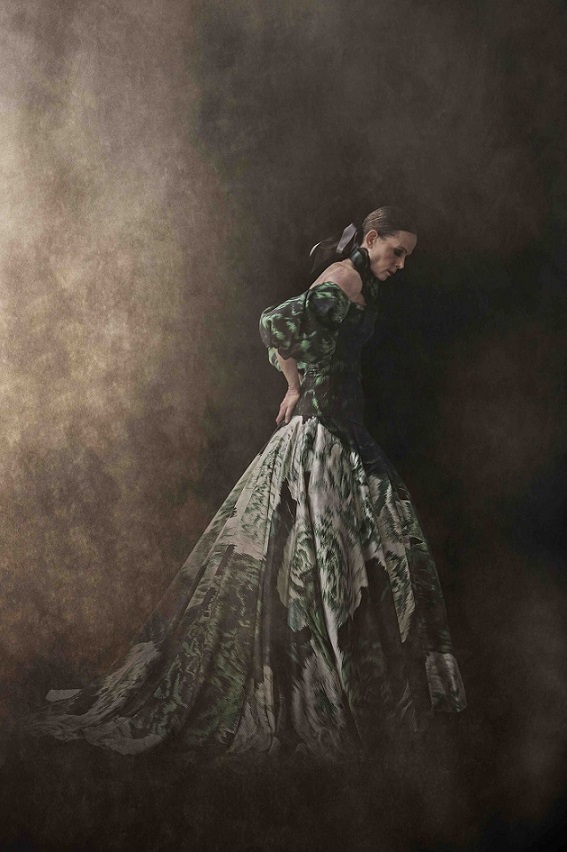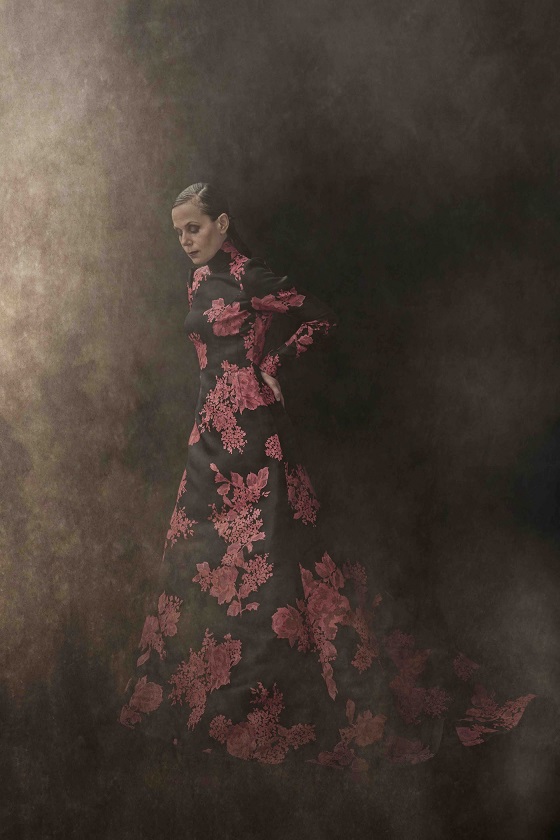The current drama around the Swedish Academy has reached Shakespearian proportions, and might even flip the way we look at contemporary culture.
Sara Danius in a gown designed by Pär Engsheden for the 2015 Nobel Dinner; photo: Carl Bengtsson / Skarp Agent (courtesy Carl Bengtsson)
STOCKHOLM — David Bowie once said, talking about Marcel Duchamp, ”Once something is categorized and accepted, it becomes part of the tyranny of the mainstream, and it loses its potency.”
It may seem strange to link Bowie’s quote to one of the most established cultural institutions in the world, The Swedish Academy, i.e. that secretive group in Stockholm charged with selecting the winner of the Nobel Prize in Literature. But in fact it does have a peculiar logic. The current drama around the Academy has, at least in Sweden, reached Shakespearian proportions and might even flip the way we look upon contemporary culture.
Academy members, who are appointed for life, are supposedly sworn to silence regarding every single word uttered within the Academy walls. As of this writing, the required 18 members are down to 10, and some of them have been making public statements about the Academy and fellow members just about every day — or at least that it what it feels like.
It is an understatement to say that the past months have been dramatic; they have in fact been outrageous, chaotic, and even, some would claim, disastrous — meaning that the Academy scandal has forever ruined Sweden’s reputation as a cultural lodestar. The drama has all the necessary ingredients: sex, abuse, power, money — and, of course, culture’s position in society.
I will leave aside the scandal itself, however; thousands of articles have already been written about it. Instead I want to look at the story from what would seem to be a pretty obvious angle: the point of view of art. With the Academy’s status as one of the world’s most prominent literary clubs, and with the key actors in the current drama being some of Sweden’s most prominent writers, this might just be a valid idea.
Perhaps the most salient thing to keep in mind is that the dispute did not begin as an Academy scandal per se. It started with sexual harassment allegations against the husband of an Academy member, Katarina Frostenson, from no less than 18 women. But it soon turned into a battle within the Academy, lending a high-brow touch to the kind of controversy that is usually tacky and Trumpian, lacking in the more sophisticated layers of culture.
So, maybe the Academy drama brings us back to a long-lost era, activating a temps perdu when art had to shock the bourgeoisie in order to give birth to the New. The sort of thing that happened in the 20th century, with Marcel Duchamp, Igor Stravinsky, Pablo Picasso, and — why not? — The Beatles.

Sara Danius in a gown designed by Pär Engsheden for the 2016 Nobel Dinner; photo: Carl Bengtsson / Skarp Agent (courtesy Carl Bengtsson)
The Swedish Academy is indeed grand, pompous, larger than life – founded by king Gustav III in 1786. It has selected the winner of the Nobel Prize in Literature since 1901. It seems that the rules and regulations of the Academy are still the ones Gustav wrote the year that it opened. As a consequence, the question has been out there for a long time: is it possible to maintain the quality of a storied institution and still update it to contemporary standards?
That is why, from an artistic point of view, the Academy scandal has, for me, turned into a battle between Friedrich Hölderlin and The Thin White Duke.
Here is the story:
Not many people noticed it, but right after Bob Dylan became the 2016 Nobel Prize laureate, the (until recently) Permanent Secretary of the Swedish Academy, Sara Danius, was asked her personal opinion on Dylan. She answered, almost en-passant, that she was more of a Bowie fan, thereby slipping us a key.
Bob Dylan had for ages been mentioned as a possible Nobel Prize winner. But Bowie — that was a different twist. What I realized then and there was that the spirit of David Bowie has hovered over the way she has been staging her job ever since she became the Permanent Secretary of the Swedish Academy.
When, in 2015, Danius made her debut in the job, she descended the staircase to the Nobel Dinner in the Blue Hall as if it were a truly historical world stage. She was wearing a gown designed by Pär Engsheden in close cooperation with Danius herself, a dress well beyond normal contemporary standards. .
Danius understood the grandeur of her position and acted accordingly — that she was actually representing the outmost international symbol of Swedish culture. She was not the Academy; the Academy was something larger than herself — and if she could handle the job, i.e. to maintain and update the standards of the Academy, she had to take as her starting point the magnitude of the situation.
She dressed herself in designer gowns not simply to make a splash at the Nobel dinner, but to fulfill her role as a cultural spearhead, someone to shake up musty attitudes. As a consequence, the dresses she wore to the Nobel dinners transformed the discussions of fashion, bringing them back to an earlier time when matters of style were treated as matters of content. In fact, the dresses she wore and her manner of being — based on equal parts humor and intelligence — generated a necessary distance from the Academy’s past and opened up a variety of potential futures.

Sara Danius in a gown designed by Pär Engsheden for the 2017 Nobel Dinner; photo: Carl Bengtsson / Skarp Agent (courtesy Carl Bengtsson)
Her way of heading the Academy can very well be compared to David Bowie’s entry into London’s world of rock’n’roll in the 1970’s. Bowie sensed his own greatness and was able to cope with it, as many great artists do, by surpassing his context.
David Bowie was the opposite of your ordinary rock star. He invented a series of alter egos to distance himself from a market that would swallow the identities of many other, less savvy musicians. He turned himself into Ziggy Stardust and Alladin Sane, personas that enabled him to play with pop culture’s soon-to-implode future. He handled the leap across the Atlantic to the US by turning himself into The Thin White Duke — and kept on changing even after his death (”dropped my cell-phone down below…”).
David Bowie is in this sense a descendant of Marcel Duchamp, who, through Rrose Selavy, could play with both gender and life. Marcel Duchamp too felt a need to surpass his context, the art world of Paris. When, late in life, Duchamp was asked by professor Ulf Linde whey he moved to New York in 1915, he replied: “The art life in Paris had already turned into the market’s need for Braque and Picasso — and I didn’t want play on such a low level.”
The photographs taken by Carl Bengtsson of Sara Danius in Engsheden’s gowns are related to the shape-shifting images of Bowie and Duchamp: They make her into an actor. She and the Academy are decidedly not the same. They are different entities, coming from different worlds.
She is there, onstage, but handling the responsibility by keeping a distance, by being outside. It is as if ishe can conduct her business to transform an old institution only when she is playing a role. She even invented a persona for smaller events, an alter ego named Gittan P Jönsson, through which she, the Permanent Secretary, could suddenly act as an angry lady from the South of Sweden, with little or no knowledge of literature. The appearance of Jönsson at Akademy functions is said to have been a tough thing to handle for those lacking a sense of humor.
Compare Danius’s gestures with the demeanor of Horace Engdahl, a previous Permanent Secretary, who is rumored to be her leading opponent in the Academy turmoil. In photographs taken outside the Academy building at the height of the scandal, he is seen laughing at journalists as if he embodied and personified the entire institution. He laughs as if he were the Academy laughing.
Conincidentally, Engdahl’s writing has largely focused on German Romantic poets. The Thin White Duke and Rrose Selavy are thus pitted against the doomed poet Friedrich Hölderlin. Externalizing against internalizing. A distanced persona against a self blurred with its context.
Friedrich Hölderlin (1770-1843) lost his mental health and lived the last 36 years of his life in the house of the carpenter Ernst Zimmer, out of touch with the external world. Is this the destiny awaiting the Academy? Or will the furor be an opportunity for reinvention, for multiple roles in a rapidly expanding cultural universe?
As work of contemporary art, the Academy scandal has a potential to disrupt an old institution, as well as old models of cultural production, as they turn and face the strange — ch-ch-changes.


